
Pyrausta is a speciose genus of moths of the family Crambidae. The genus was erected by Franz von Paula Schrank in 1802.

Pyrausta californicalis, the California pyrausta moth, is a moth in the family Crambidae. It was described by Alpheus Spring Packard in 1873. It is found in North America, where it has been recorded from British Columbia to California.

Pyrausta comastis is a moth in the family Crambidae. This species is endemic to New Zealand. It has been classified as "nationally vulnerable" by the Department of Conservation.
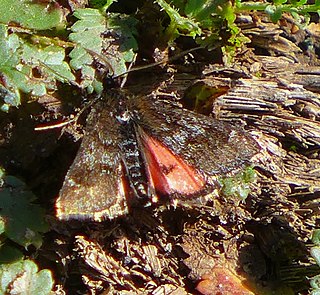
Pyrausta dapalis is a moth in the family Crambidae. It was described by Augustus Radcliffe Grote in 1881. It is found in western North America, where it has been recorded from California and Oregon.

Pyrausta flavofascialis is a moth in the family Crambidae. It was described by Augustus Radcliffe Grote in 1882. It is found in North America, where it has been recorded from western Texas to Arizona. It is also found in Mexico.

Pyrausta fodinalis is a moth in the family Crambidae. It was described by Julius Lederer in 1863. It is found in North America, where it has been recorded from British Columbia to Quebec and the north-eastern United States. It is also present in California, Nevada, Colorado and Wyoming. The habitat consists of undisturbed prairie and grassland areas.

Pyrausta generosa is a moth in the family Crambidae. It was described by Augustus Radcliffe Grote and Coleman Townsend Robinson in 1867. It is found in North America, where it has been recorded from Ontario to Alberta and to Florida and Missouri. The habitat consists of undisturbed areas in aspen parkland and mixed woods.
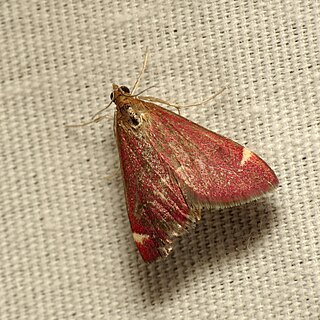
Pyrausta grotei is a moth in the family Crambidae. It was described by Eugene G. Munroe in 1976. It is found in North America, where it has been recorded from Washington, Oregon, Montana, California, Utah, Colorado, Wyoming, Nevada, Arizona and Texas.

Pyrausta homonymalis is a moth in the family Crambidae. It was described by Eugene G. Munroe in 1976. It is found in North America, where it has been recorded from Missouri to Virginia, Mississippi and Florida, west to Texas.

Pyrausta inornatalis, the inornate pyrausta moth, is a moth in the family Crambidae. It was described by Charles H. Fernald in 1885. It is found in United States, where it has been recorded from Arizona, California, Florida, Arkansas, Kansas, Louisiana, Missouri, Oklahoma, Tennessee and Texas. It is also found in Mexico.

Pyrausta insignitalis, the dark-banded pyrausta moth, is a moth in the family Crambidae. It was described by Achille Guenée in 1854. It is found in the United States, where it has been recorded from Florida and South Carolina. It is also found on the West Indies, as well as in Central and South America.

Pyrausta lethalis, the lethal pyrausta moth, is a moth in the family Crambidae. It was described by Augustus Radcliffe Grote in 1881. It is found in North America, where it has been recorded from California to southern Nevada, southern Arizona and Texas.
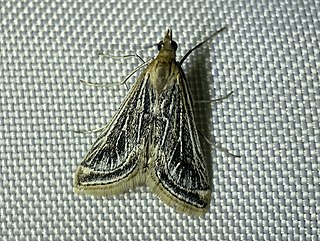
Pyrausta linealis is a moth in the family Crambidae. It was described by Charles H. Fernald in 1894. It is found in North America, where it has been recorded from eastern Washington to California and Nevada.

Pyrausta nexalis, the fulvous-edged pyrausta moth, is a moth in the family Crambidae. It was described by George Duryea Hulst in 1886. It is found in North America, where it has been recorded from Washington, Montana, Arizona, California, New Mexico, Oklahoma, Texas and Utah.

Pyrausta perrubralis is a moth in the family Crambidae. It was described by Packard in 1873. It is found in North America, where it has been recorded from British Columbia, California, New Mexico, Oregon and Washington.
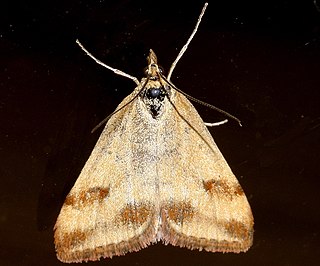
Pyrausta semirubralis is a moth in the family Crambidae. It was described by Alpheus Spring Packard in 1873. It is found in North America, where it has been recorded from southern British Columbia to California, Nevada, Colorado and Arizona. The habitat consists of coastal areas, reaching inland up to altitudes of about 9000 ft.
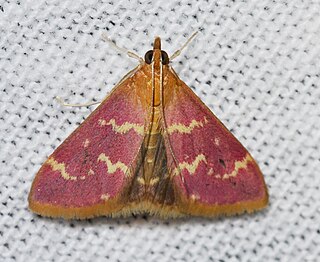
Pyrausta signatalis, the raspberry pyrausta moth, is a moth in the family Crambidae. It was described by Francis Walker in 1866. It is found in North America, where it has been recorded from British Columbia to Ontario, south to North Carolina, South Carolina, Texas and Arizona. The habitat consists of aspen parkland and grasslands.
Pyrausta tatalis is a moth in the family Crambidae. It was described by Augustus Radcliffe Grote in 1877. It is found in North America, where it has been recorded from California to Texas and Oklahoma.

Pyrausta tyralis, the coffee-loving pyrausta moth, is a moth in the family Crambidae. It was described by Achille Guenée in 1854. It is found in the United States, where it has been recorded from New York to Illinois and from Florida to Arizona. It is also found from Mexico to Venezuela, as well as on the West Indies.
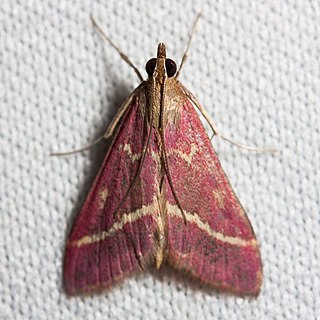
Pyrausta volupialis, the volupial pyrausta moth, is a moth in the family Crambidae. It was described by Augustus Radcliffe Grote in 1877. It is found in North America, where it has been recorded from Oklahoma, Utah, Texas, Colorado, New Mexico, Arizona and California to Chiapas, Mexico.


















